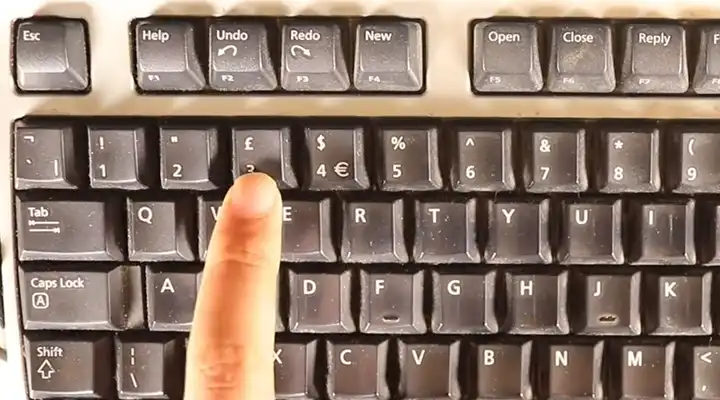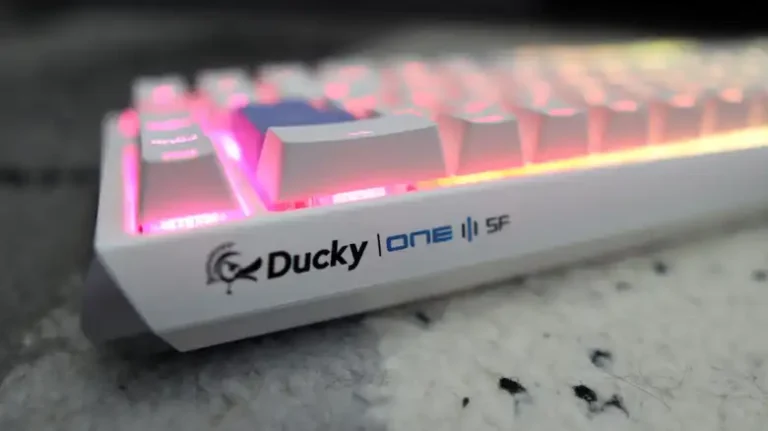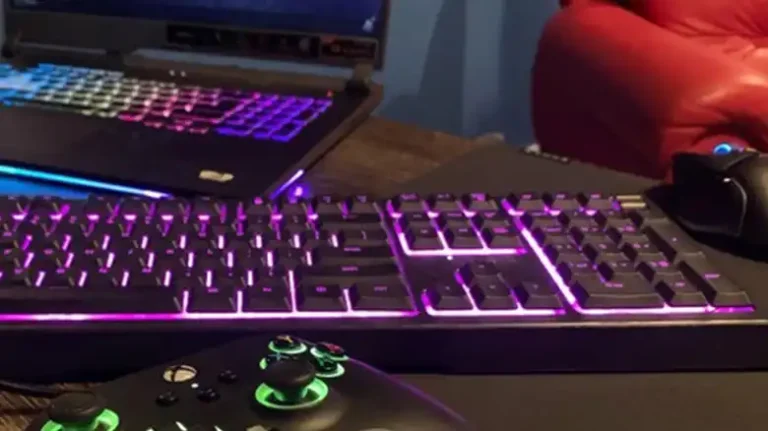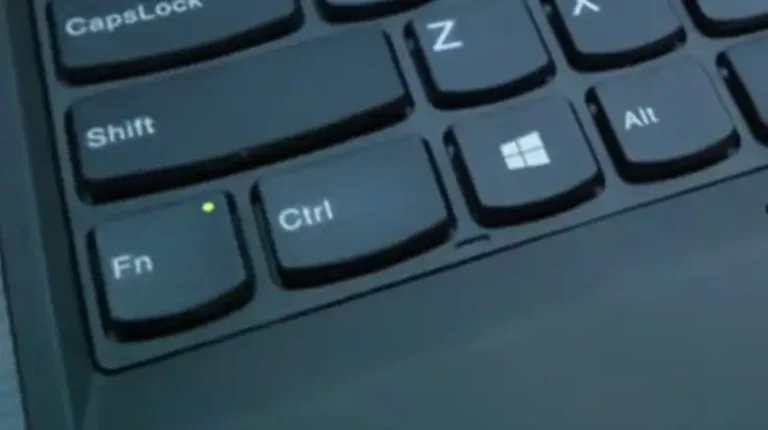Pound Sign on the Keyboard Not Working
I rely on using the pound/number sign key countless times per day across everything from entering passwords to programming. So when my £ key literally stopped responding out of the blue one afternoon, I have to admit it drove me crazy!
No matter how many times I pressed, that critical symbol refused to actually type on the screen. I knew how often the hash key gets used for shorthand commands and coding, so leaving it broken was not an option. After smashing it in frustration achieved nothing, I realized more strategic troubleshooting was required!
Thankfully with some methodical tests, driver updates, and clever workarounds, I managed to get my unresponsive keyboard hash key functioning again smoothly.
Throughout the frustrating issue I made notes on the steps taken, so thought it would be helpful to share everything I learned to help anyone else pulling their hair out over a broken number sign key! Read on for my complete troubleshooting journey…

Reasons Why Your Number or Pound Key May Not Be Working
There are a few possible reasons why your pound/number sign key has suddenly stopped responding:
Physical Damage or Dirt
The issue is quite straightforward – the key itself has become physically stuck or obstructed so pressing it no longer registers on your PC. This could have been caused by:
- Dirt, dust, or crumbs around the key preventing smooth presses
- Accidental coffee/liquid spill on the keyboard
- General wear and tear of the mechanical key over time
Software or Driver Issues
Problems with your Windows settings, language configuration, or corrupt keyboard drivers can prevent the key press from being detected:
- Accidental keyboard layout or language change hiding the £ sign key
- Outdated or buggy keyboard drivers not communicating properly
- App or program remapped the £ sign to perform another function
Usually, a simple driver update or computer restart will get software issues back on track.
Failing Keyboard Electronics
In some cases of older keyboards, the underlying circuit board or electronics can start deteriorating over time. Issues here will likely affect multiple keys making a replacement necessary.
Now you know why the problem may be occurring, read on for the top troubleshooting steps to get your £ key working again in Windows.
Troubleshooting Steps to Fix a Non-Responsive Pound/Number Key
Follow these methods below to determine exactly why your number sign key has stopped working:
Way 1 – Check For Physical Damage or Debris
Examine your keyboard closely under bright lighting to spot any stray hairs, dirt, or liquid residue that could be obstructing the key.
Carefully remove any debris with compressed air, alcohol wipes, or water depending on the type of keyboard.
Look for any signs of the key being cracked, misaligned, or not springing up fully when pressed. Any physical damage likely requires a professional repair or replacement.
Way 2 – Test Number Key in Another Program
Open a simple program like Word or Notepad and try typing the £ symbol there. If the sign appears as normal, then an application-specific software remapping is likely in play.
Go into that program’s settings/configuration and return the £ key functionality back to default if possible.
If working in a browser, refreshing/emptying cached data as outdated objects can cause odd issues like this occasionally.
Way 3 – Toggle Your Windows Keyboard Layouts
A common accidental change that can hide keys is toggling your Windows input language and keyboard layouts.
- Press the Windows key + I to open the Settings and then navigate to Language Settings.
- Under Prefer Language, ensure your desired language is selected as UK Layout. If it isn’t then click on Add a language and add UK English.
- After installing, click on the English (UK) and click on the Up arrow and it will be set as default.
Also, you can install the UK English Layout without downloading the entire language package. Click on the Preferred Language > Add a Keyboard > United Kingdom.
Way 4 – Restart Your Computer
If the £ key works normally within say the BIOS or login screen but fails again in Windows, a full reboot is needed.
Persistent software issues can often be cleared with a simple restart. This refreshes all drivers and clears any stuck memory caches related to the keyboard.
- Save work and close all programs
- Choose the Restart option after clicking Power
- Test number key functionality once back in Windows
If working now, software was likely the cause. If not responding still, it points to a physical issue.
Way 5 – Update Keyboard Drivers
Outdated, buggy, or corrupted drivers are a common source of keyboard input issues in Windows 10 and 11.
Updating to the latest driver from your device manufacturer will clear these conflicts up.
- Press Windows + x and then click on Device Manager
- Expand Keyboards list
- Right-click on your keyboard
- Click on Update Driver > Search Automatically
Allow Windows to freshly install keyboard drivers appropriate for your hardware. Then test the £ key again.
Way 6 – Use the On-Screen Keyboard Accessibility Tool
The On-Screen Keyboard tool built into Windows can help pinpoint hardware from software trigger issues.
Open the utility and toggle on the number panel to test making the £ symbol:
- Press Windows Key + Clt + O
- Try to insert £ into the text field
- If a symbol appears, your physical keyboard has issues
- No symbol points to wider system/software conflicts
Use this virtual tool as a backup while sorting main keyboard problems.
Way 7 – Use Compressed Air to Clean the Keyboard
Build-up around the intricate key mechanisms can stop smooth presses from registering.
Use a can of compressed air to blast away any stray particles inside laptop keyboards and between external keyboard keys:
- Power off and detach external keyboards
- Angle can nozzle ~1 inch away from keys
- Blast short bursts around problem keys and housing
- Compressed air dislodges most debris
- Remove the last bits with alcohol wipes if needed
Be extremely gentle cleaning laptop keyboards directly to avoid any internal damage. Test £ key responsiveness once done.
Way 8 – Use the Keyboard on Another Computer
To isolate wider system problems, connecting your keyboard to another Windows 10/11 PC can identify if issues are being caused locally or device-wide.
With the system powered off:
- Disconnect the current keyboard safely
- Plug the keyboard into a working computer
- Power on the test system and login
- Check if the £ key types correct within the programs
If issues persist on other devices, general electronics failure within the keyboard is likely at fault rather than wider PC problems. Consider replacement.
Temporary Workarounds for an Unresponsive £ Key
If all standard troubleshooting steps fail, these smart techniques offer temporary ways to mimic a £ sign functionally while you think about longer-term repairs or replacements:
Create Custom Text Replacement Shortcuts
Configure text replacement rules within Windows so shortcut phrases automatically expand out to problem characters:
- Install Power Toys on your PC
- Next, click on the three-dash icon at the top left corner and then go to Keyboard Manager.
- Then, click on Remap a Key. After that Remap number 3 to a different key.
- After that save the change and then you will be able to have the pound key without any issue.
Use Number Pad to Type
External keyboards usually have a number pad section. Enable Num Lock then press the hash located there instead for the time being.
Windows:
Alt+0163
Mac:
Option+3
Linux:
Control + Shift + u + a + 3
Use the Windows Character Map
The Character Map contains a vast array of special symbols, accents, and foreign characters.
- Windows Key + R
- Type Charmap and press Enter
- Navigate to £ sign and double-click to copy
- Now just paste where needed
Having this utility easily accessible on your taskbar or Start Menu helps when typing lots of obscure characters.
What If My Pound/Number Key Fixes Completely Failed to Work?
If you’ve tried all troubleshooting steps exhaustively but the issues persist unabated, more invasive solutions may be needed:
Buy a New External Keyboard
Consider purchasing an affordable external keyboard to use instead of day-to-day rather than immediately replacing a laptop.
Jelly Comb and Logitech make great plug-and-play wireless models under $20. Use this as a temporary workaround before committing to pricey laptop repairs.
Initiate a Warranty Keyboard Repair/Replacement
If your machine is still under warranty period, contact manufacturer support about arranging repair or replacement.
They can ship a new matching keyboard and guide you through the steps to safely replace yourself or set up an authorized service center slot.
Visit an Electronics Repair Store
For older laptops out of warranty, visiting a reputable local electronics repair shop for professional maintenance may be the most cost-effective.
Describe the keyboard issues in detail so the technicians can accurately diagnose faults and provide quotes for fixes/replacement parts.
Contact Customer Support for Aid
Lastly, keyboard manufacturers, laptop makers and operating system providers like Microsoft have dedicated customer help teams to assist with all hardware and software issues encountered.
Explain precisely what troubleshooting you’ve attempted already then follow their specialized product advice. Recording videos of any odd behavior can help remotely diagnose.
They may arrange replacement/repair options depending on warranty status. But insist on solutions – a working £ key is critical!
Conclusion: Resolve Your Unresponsive Pound Key Issue for Smooth Sailing Ahead!
Getting frustrated when your critical number sign key fails to work is understandable. But hopefully, with the comprehensive troubleshooting, workarounds, and last resort replacement options outlined here you can get back to reliably accessing the £ sign once again!
Always start by methodically testing for debris issues, and software conflicts and seeking simple driver updates first before resorting to costly hardware repairs or replacements if possible.
Stay calm and attack the issue systematically using this advice. And remember that one stubborn unresponsive key will not defeat you! You’ve got this – now get £ typing once more.
Let me know in the comments if you encounter any other clever keyboard tricks during your repairs. And don’t forget to give your helpful key companions an occasional blast of clean compressed air!
![Rugged Folio for iPad Keyboard not Working [How to Fix]](https://keyboardhunter.com/wp-content/uploads/2023/10/Rugged-Folio-for-iPad-Keyboard-not-Working-768x431.webp)



![[Explained] Can You Clean Keycaps with Isopropyl Alcohol?](https://keyboardhunter.com/wp-content/uploads/2023/10/Can-You-Clean-Keycaps-with-Isopropyl-Alcohol-768x431.webp)
![[5 Fixes] Wireless Keyboard 850 Not Working](https://keyboardhunter.com/wp-content/uploads/2023/08/wireless-keyboard-850-not-working-768x431.webp)